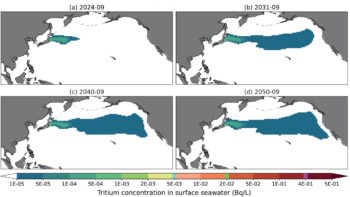
A new system for removing salt from seawater using the waste heat from solar panels has been created by Peng Wang and colleagues at King Abdullah University of Science and Technology in Saudi Arabia. The team installed a multistage membrane distillation (MSMD) device directly underneath the solar panels so that the system occupies the same footprint as the solar panels.
Energy and water are two crucial resources that are often connected. Creating freshwater from seawater consumes about 15% of electricity generated in Arab countries, for example, and finding carbon-free sources of energy for desalination is a huge challenge facing countries in the driest regions of the world.
Wang’s team have answered this challenge by creating a desalination system that uses waste heat produced by solar power plants. While solar cells can convert about 20% of sunlight into electricity, the remaining 80% simply heats up the solar panels. The team’s MSMD device comprises three stacked layers of water distillation channels that run parallel to solar panels. Each layer is separated by porous hydrophobic membranes and heat conduction layers.
Evaporation and condensation
Within each layer, seawater in the uppermost channel is evaporated by waste heat from the solar panel, and then condenses to freshwater inside a second channel on the other side of the membrane. This desalinated water then flows into a storage container, while the remaining seawater, along with the rest of the waste heat, pass down to the layer below, where the process repeats.

Salt-free drinkable water comes at a cost
Wang and colleagues show that the MSMD device can be installed directly underneath existing solar panels; requiring no specialized mounting equipment, and no extra requirements for land use. While previous attempts at this technique came at the cost of overall solar panel performance, the researchers observed virtually no decrease in power generation efficiency in their system. At the same time, the MSMD device was able to desalinate up to 1.64 l of fresh water per square metre per hour. According to team member Wenbin Wang, this is more than double the water output of traditional solar stills, which use a one-stage design.
The team points that new technology could encourage energy and water companies to work together in dry regions. Furthermore, they point out that creating fresh water offers a way of mitigating the inherent low efficiency of solar panels and could make their deployment more attractive.
As a next step, the team wants to study how the system could be used in an agricultural setting – with the water used for irrigation.
The desalination system is described in Nature Communications.



